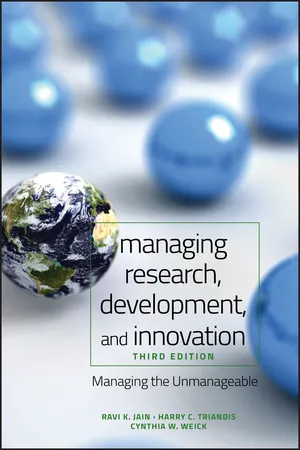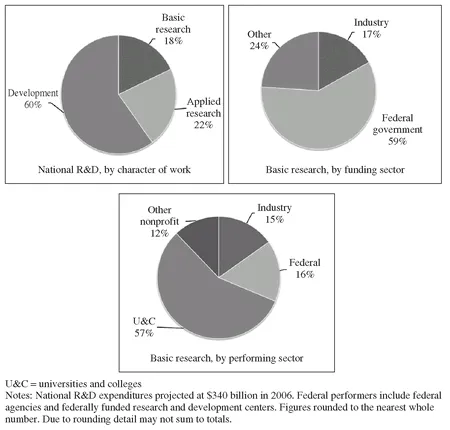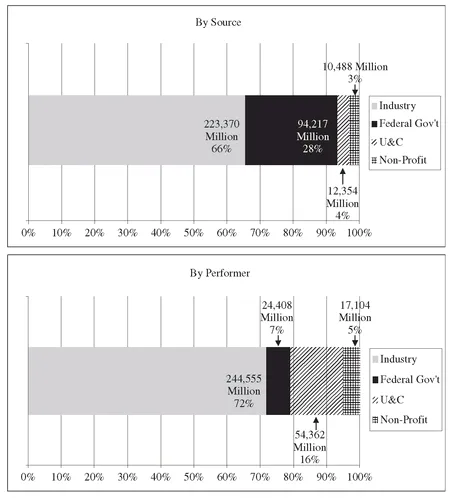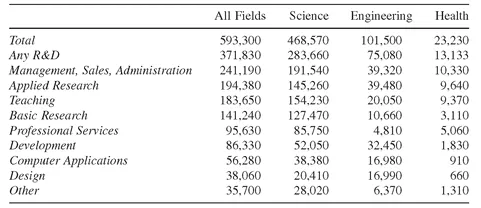![]()
R&D ORGANIZATIONS AND RESEARCH CATEGORIES
Clockmakers were the first consciously to apply the theories of mechanics and physics to the making of machines. Progress came from the collaboration of scientists—Galileo, Huygens, Hooke, and others—with craftsmen and mechanics.
DANIEL J. BOORSTIN
The Discoverers
The historic collaboration between scientists and craftsmen to create the clock, which Boorstin calls “the mother of machines,” represents a rudimentary R&D organization.
Today the complexity of the technology has created correspondingly complex organizations, with sometimes hundreds of employees. Many disciplines have to be coordinated and it’s the manager who brings the many components together so they can function smoothly, each making an optimal contribution to the R&D organization. Thus, today, as in the past, progress requires collaboration.
Managing a research and development (R&D) organization is, to a great degree, the art of integrating the efforts of its many participants. Beyond this, the manager has to provide order, purpose, and foresight and do this while dealing intelligently with the uncertainty inherent in an R&D enterprise. Considering the important role R&D plays in the economic well-being of a nation, the profitability of a business enterprise, the effectiveness of a technology-based governmental agency (e.g., the Department of Defense), and the enormous investment nations make in R&D activities ($355 billion in the Unites States in 2007), effective R&D management can have profound and far-reaching consequences. Effective management, coupled with a vigorous research and science policy, is necessary for a nation to sustain economic growth, provide a strong national defense at an affordable cost, and maintain a position of leadership in the international community. It is therefore important to understand R&D organizations and their relationship to society. For this reason, the first chapter provides some basic definitions of research categories and research organizations and chapter 17 covers macro issues related to R&D and science policy. This information should be useful to those who conduct and manage research, and especially to those who seek funding support for research and who want to develop allies in influencing science policy.
This chapter first provides a perspective on R&D management and then discusses research and development definitions and categories. Sections that follow examine the question: What to research? This is in some respects a key question for an R&D manager. To what extent, for instance, should the manager allow basic research to be done in addition to the applied research needed by the organization? What is the best way to establish priorities among competing research projects? There are numerous suggestions in the literature on how to do that. Since a question is often raised as to what is so unique about an R&D organization management, a discussion of this issue is included in this introductory chapter.
1.1 HOW INFORMATION CAN BE USED
Some readers may want to take a cursory look at the information presented in this chapter and keep in mind how some of it may help them. In addition to having important implications for R&D management, this information has other possible uses as well. Some examples follow.
As a principal investigator (PI), if you are interested in being involved primarily in basic research, in what kind of an organization should you be seeking employment? If you’re working in industry you should not be too surprised if you are required to focus your efforts on “products and profits.” As shown in Figure 1.1, on the average, 60 percent R&D is focused on product development, 22 percent on applied research, and only about 18 percent R&D is devoted to basic research. Expenditures on R&D by source and performer are shown in Figure 1.2.
In this chapter, indeed in this book, we argue that, in a productive and effective research organization, a researcher should have a mix of activities including basic, applied, and product development research. Examples of successful organizations and results of studies conducted are provided to support this assertion. For a manager of an R&D organization interested in productivity and effectiveness, understanding this issue is crucial and has important managerial implications. If we are successful in persuading you to include basic research in your mix of activities, even if your organization focuses on product development, would you not use the information in this chapter to persuade corporate decision-makers to allow this flexibility?
Is there any R&D manager who has not been accused of being unresponsive to customer needs and of focusing on esoteric, nonproductive research activities? Throughout this book a strong case has been made for customer participation in needs assessment and in the innovation process. The issue is much broader.
Figure 1.1. Relative Distribution of U.S. R&D Expenditures by Source, Performer, and Character of R&D: 2006
(Source: Science and Engineering Indicators 2008, p. 4-15.)
Let us consider an R&D organization that works only on those research needs identified by the customer. Would such an organization not be working on yesterday’s, or, at best, today’s problems in a very narrow framework? Using this approach, during World War II, would researchers have been working on bigger and better binoculars to detect incoming airplanes rather than on developing radar?
We propose a two-tier model, which includes an economic index model and a portfolio model that should overcome some of these difficulties. Further, a systematic and a conceptual approach for prioritizing potential projects is presented. Depending on the organizational setting and the decision-makers involved, this approach provides a crucial mechanism for research project selection and effective decision-making. By being systematic, it also gives psychological comfort to the decision-makers.
Figure 1.2. The National R&D Effort
(Source: http://www.nsf.gov/statistics/seind04/c4/tt04-01.htm (table 4-1). [Science and Engineering Indicators, 2004.])
Oh yes, how about these mundane definitions! Anyone involved in research knows them, or should know them. Maybe so. Careful reading would show that there are some key points brought out that are not commonly appreciated. For example, what really differentiates basic research from applied research? Basic research is not inevitably unapplied. Differences lie elsewhere. If nothing else, these definitions may facilitate communication among the various actors involved in conducting and sponsoring research.
1.2 A PERSPECTIVE ON R&D MANAGEMENT
The ideas presented in this book focus on ways to improve the productivity of R&D organizations and foster excellence in such organizations. The book is primarily aimed at principal investigators, their colleagues, and supervisors. As indicated, others may also find the information presented here interesting.
In mathematics or physics, most concepts can be readily judged as useful or worthless. Management concepts, on the other hand, are more difficult to evaluate. The following example might illustrate the case.
One well-known scientist was recruited to be vice president of a biotechnology company. In trying to prepare for this important new position he took a course at the California Institute of Technology on “Managing Research and Development.” After completing the course the scientist felt that it had failed to teach him how to prioritize and manage research projects. On his evaluation he stated that the course had been “expensive and worthless.” In response to this criticism, the course program director pointed out that the scientist had “completely misunderstood the goals of the course.” According to the director, the course was geared toward planning research and development activities rather than managing scientists (Wall Street Journal , November 10, 1986).
Managing researchers is one of the most daunting tasks a manager can undertake. It’s not clear how one plans or anticipates a “scientific breakthrough.” If this is the case, is there any point in undertaking extensive efforts in strategic planning or doing any planning at all? Scientists are thought to be dedicated to ideas and research. However, as shown in Figure 1.1, a majority of the R&D is devoted to product development and applied research, and less to basic research. The challenge then is to provide a mix of activities to achieve organizational goals and sustain the researcher’s motivation and curiosity, which are essential to scientific breakthroughs and product development.
The effect public policy and management decisions have on the resources available for R&D is well understood; one also needs to consider and understand the important role engineers and scientists can and should play in developing science policy. Of the approximately 595,000 doctoral scientists and engineers employed in the United States as of 2003, approximately 372,000 work in R&D. Of the 372,000, it is estimated that about 60,000 work in management of R&D. The remaining doctoral scientists and engineers are involved in many forms of professional practice, in addition to the substantial number who teach (184,000). Those involved in professional services and consulting number nearly 96,000. Consulting engineers and scientists undertake creative activities that are, in many ways, responsible for closing the loop between research and development and application. Table 1.1 shows the primary and secondary work activities of doctoral scientists and engineers (note that respondents could choose more than one category).
A doctorate is a research degree, and the majority of scientists and engineers with PhDs work in research, development, and teaching. It is significant that relatively few engineers, as compared to scientists, hold doctoral degrees. In 2003, 101,500 engineers held doctorates but this represented only about 7 percent of all employed engineers. Among scientists, however, about 23 percent hold doctorates (Science and Engineering Indicators, 2003 ).
TABLE 1.1 Employed Doctoral Scientists and Engineers, by Primary or Secondary Work Activity: 2003
Source: Characteristics of Doctoral Scientists and Engineers in the United States, Table 16, 2004.
We favor managers of R&D organizations with high-level technical skills, because studies have clearly shown that where supervisors were rated highest in technical skills the research groups were most innovative. And where supervisors did not possess excellent technical skills (but had high-level administrative skills), the research groups were least innovative (Farris, 1982, p. 340). These findings in no way minimize the importance of administrative skills, but rather point to a fundamental need for a supervisor in an R&D organization who possesses excellent technical skills. Ideally, both kinds of skills should be available to a manager. Consequently, the role of a scientist1 in managing R&D organizations has been and will continue to be an important one.
To make sure we communicate effectively, we must first define some basic terms. We will do this in the next section.
1.3 WHAT IS RESEARCH AND DEVELOPMENT?
The National Science Foundation (NSF) classifies and defines research as follows (
Science and Engineering Indicators, 2008):
Basic Research. Basic research has as its objective “a more complete knowledge or understanding of the subject under study, without specific applications in mind.” To take into account industrial goals, NSF modifies this definition for the industry sector to indicate that basic research advances scientific knowledge “but does not have specific immediate commercial objectives, although it may be in fields of present or potential commercial interest.”
Applied Research. Applied research is directed toward gaining “knowledge or understanding to determine the means by which a specific, recognized need may be met.” In industry, applied research includes investigations directed “to discovering new scientific knowledge that has specific commercial objectives with respect to products, processes, or services.”
Development. Development is the “systematic use of the knowledge or understanding gained from research, directed toward the production of useful materials, devices, systems or methods, including design and development of prototypes and processes.”
In its publication
The Measurement of Scientific and Technical Activities (1993), the Organization for Economic Co-operation and Development (OECD) defines some research activities as follows:
Basic research is experimental or theoretical work undertaken primarily to acquire new knowledge of the underlying foundations of phenomena and observable facts, without any particular application or use in view. Basic res...




